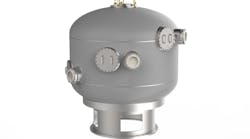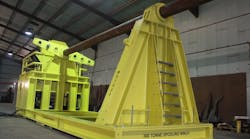Editor's note: This Beyond the Horizon first appeared in the July-August 2023 issue of Offshore magazine. Click here to view the full issue.
By Kent Brown, Cambium Networks
In a commodity business, the provider with the lower cost structure will have an advantage. We’re seeing that business aphorism play out in the energy industry, where producers with an effective broadband connectivity strategy are realizing sustainable cost savings.
But while gas and oil fields are all connected wirelessly nowadays, the nature of that connectivity is very different from what it was just a few years ago.
With the likes of Chevron, Occidental, ExxonMobil, BP, and ConocoPhillips leading the way, a shift is underway in the oil and gas industry with more operators investing in fixed wireless infrastructure to handle the growing data-centric demands of their business.
Here’s why. Oil and gas exploration and production often take place on offshore platforms or in remote, land-based facilities and fields, where working in often harsh locations presents myriad challenges. For one thing, modern infrastructures need centrally managed, secure and reliable connectivity to handle SCADA process control networks, data generated by sensors, and other Internet of Things (IoT) devices. In addition, they depend upon high-speed internet access to communicate with vendors, colleagues, and headquarters in real time.
Here’s where things get complicated. The industry wouldn’t get very far down this path if it still relied on narrowband technology to handle the vast amounts of video, high resolution imaging and terabytes of data being generated in fields nowadays. Data loads are orders of magnitude larger than they used to be, and more oil and gas companies require broadband connections suited to handle that volume of traffic.
What’s more, the reality is that in the face of high winds, saltwater corrosion, and extreme temperatures, it becomes prohibitively expensive to lay and maintain physical cables for wired networks to distributed locations beyond the network core. Also keep in mind that these installations often involve specialized equipment and materials that are prone to suffer damage.
Consider the challenges involved exploring for oil in gale force winds while trying to locate the exact place to drill several thousand feet below the water’s surface. Everything depends on data and if the data pipes are too slow – or worse, the system goes down and there’s no connectivity – operators are essentially going to be left flying – or, in this case, drilling – blind.
Contrast that with fixed wireless networks, which are generally easier to install and maintain – even in severe environments. Fixed wireless networking, as opposed to broadband wireless, refers to the operation of wireless devices in fixed locations such as processing facilities and offices – or even on wellheads in oil fields or offshore platforms. Another advantage: they’re more flexible and scalable and that allows companies to adapt to changing operational needs should they choose to expand their network coverage.
Let’s take a closer look at how fixed wireless is making it easier for oil and gas companies to extend their private network to oversee their operations.
In the past, managers would need to send their personnel to field sites to investigate conditions on the ground and manually write up reports and gather charts.
The internet was supposed to change all that as more oil and gas companies underwent the digitization of their infrastructures. But these older systems weren’t reliable, and polling counts and latency were a constant problem. The result: these landlocked connectivity solutions were hard-pressed to keep up with the increasing demand for higher data transmission rates between operations and field sites.
Companies were left with little choice but to again send out teams to do in-person inspections. That added to total costs and introduced an element of risk for employees required to operate in hazardous conditions because systems underperformed or malfunctioned.
Working with fixed wireless, managers can now monitor data from a network of sensors sending back readings on the performance in oil and gas fields without interruptions. They can visually see events or problems by means of high-quality video streams. With real-time data in hand, they now have greater visibility into what’s happening in the field, allowing organizations to tweak their operations proactively and respond or predict – and do it from a central location. In addition, using a single network infrastructure to provide voice services, data transfer and video surveillance applications provides significant efficiency and simplicity.
We’re only in the early stages of this transition. As fixed wireless technology continues to evolve and improve, the momentum behind its adoption will only grow as more oil and gas companies jump on the bandwagon. In the end, this is about how to improve safety, increase efficiency, extend the life of the extraction and pumping equipment and the oil field assets themselves.









